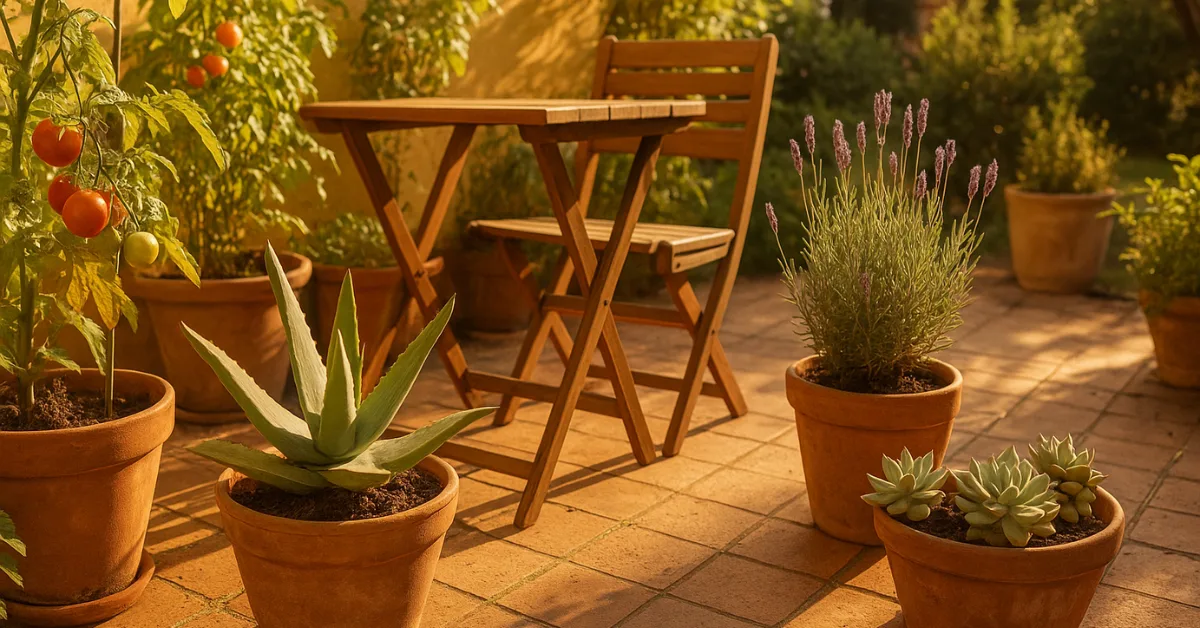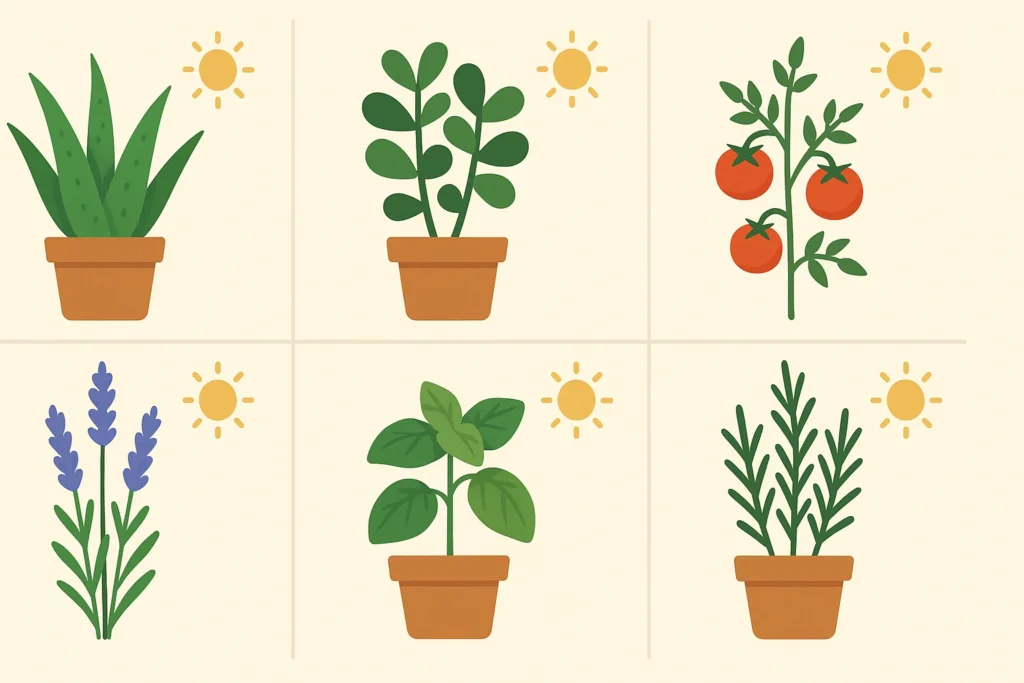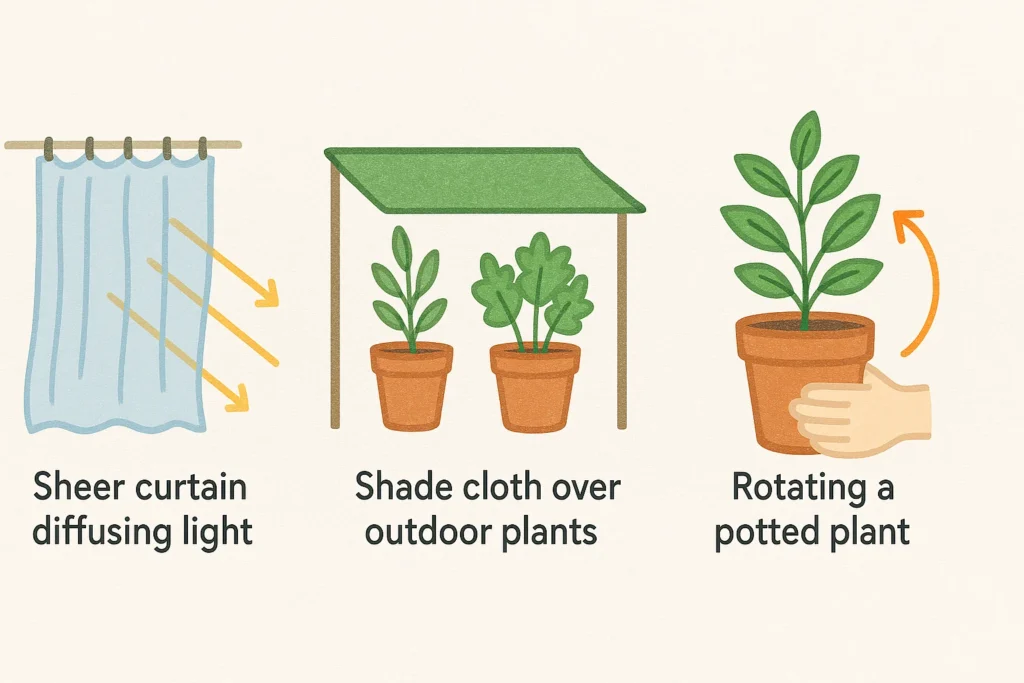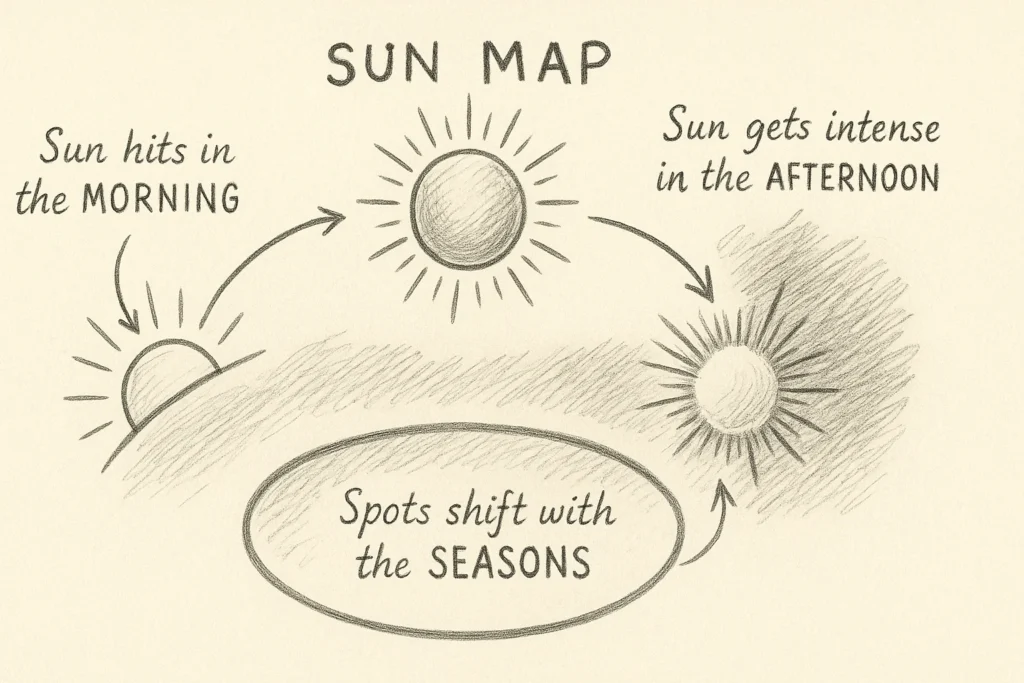Plants for Direct Sunlight: Hard-Learned Lessons on What Thrives (and What Sizzles)

Why Direct Sunlight Isn’t Always a Blessing?
When I first got serious about houseplants, I made what I now call “The Great Sunlight Assumption.” I figured, plants need light, right? So more sun must mean more growth. Logical enough.
So I lined up my new plants right by the sunniest window in the house. South-facing, full afternoon sun, blazing in like a spotlight. Within days, I noticed the leaves on my snake plant turning pale. My basil started looking bleached, like it had been left out in the desert. Meanwhile, my little aloe vera was thriving like it had found its happy place.
That’s when I realized not all plants for direct sunlight are created equal.
Some plants absolutely soak it up. Others? They’d prefer a gentle, filtered glow. And unless you know which plants need direct sunlight and which don’t, you’re playing a guessing game—with your plants paying the price.
One of the biggest misconceptions I see is this idea that more sun = better growth. While that might hold true for tomatoes or succulents, many houseplants (especially tropicals) will burn out before they ever perk up.
That’s why understanding direct sunlight for plants is so critical. Whether you’re growing herbs on a balcony, tending to houseplants, or planning an outdoor garden, knowing how much sun is too much (or too little) makes all the difference.
In this guide, I’ll walk you through:
- Which plants love direct sunlight and actually need it.
- Which plants prefer to avoid it (and why).
- Simple ways to manage sunlight for both indoor and outdoor spaces.
By the end, you’ll have a clear sense of how to match your plants to the right light—not just by reading tags, but by understanding how plants really behave in full sun.
Table of Contents
What is Direct Sunlight for Plants? (It’s Not Just “A Bright Spot”)
I used to think if a room felt bright to me, it must be plenty of light for my plants. It made sense in my head. After all, if I could read a book there, surely a plant would be happy too.
But plants see light differently than we do.
When we talk about direct sunlight for plants, we mean at least six hours of full, unfiltered sunlight hitting the plant’s leaves every single day. That’s the gold standard for sun-loving plants.
Picture a tomato plant sitting out in the garden, soaking up the afternoon rays without any shade—that’s direct sunlight. No curtains, no trees overhead, just full exposure.
Now, let’s clear up the terms that used to confuse me endlessly:
- Direct Sunlight: Full, strong sun for 6+ hours, typically south-facing outdoors or right next to a sun-drenched window.
- Indirect Sunlight: Bright but filtered—like through sheer curtains or bouncing off light-colored walls.
- Partial Sun: 3-6 hours of direct sunlight, usually morning or late afternoon.
- Dappled Sunlight: Speckled light that filters through tree branches, offering shifting patches of sun and shade.
That last one tripped me up for a while. I thought my patio with its leafy shade was “full sun” because it was outdoors. Turns out, it was more dappled sunlight, and my lavender plants weren’t amused.
One question I get a lot is: Does sunlight through a window count as direct sunlight?
The answer? It depends.
A south-facing window with no obstructions can provide solid direct light for certain indoor plants. My aloe vera, for example, thrives there. But for plants that need full outdoor sun—like tomatoes or peppers—glass just filters out too much intensity.
In truth, what we call “indoor plants for direct sunlight” are often the tougher varieties that can tolerate slightly reduced light levels indoors and still flourish.
Signs Your Plant Is Getting Too Much or Too Little Sun

(What My Basil, Snake Plant & Tomatoes Taught Me)
It wasn’t until I scorched my first basil plant that I learned plants absolutely tell you when they’re not happy with their light.
One summer, I proudly moved my basil from the kitchen to the deck. Full afternoon sun, no shade. I figured more sun = more basil. Seemed obvious. Within days, the leaves turned pale, edges crisped up like overcooked chips, and the vibrant green faded into a dull, tired yellow.
That’s what sunburn looks like on plants:
- Scorched, crispy leaf edges.
- Faded, bleached colors.
- Sometimes the leaves even curl up, trying to protect themselves.
It’s not dramatic at first. A little browning here, a few faded spots there. But it creeps up quickly if you don’t catch it.
On the flip side, I’ve had plenty of plants whisper their unhappiness with too little light.
My snake plant, for example, started reaching out like it was grasping for a light switch. The leaves grew long and thin, wobbling under their own weight. That’s leggy growth—a classic sign the plant is stretching for more light. You’ll also notice:
- Small, weak leaves.
- Dull color.
- Growth slows down to a crawl.
With some plants, it’s sneaky. You’ll think they’re “just slow growers,” when really, they’re begging for more light.
Over the years, I’ve trained myself to spot these early stress signals. A little crisping on a sun-loving succulent might be fine. But the same crisping on a fern? Red flag. Leggy stems on a tomato seedling are a sure sign it needs stronger, more direct sunlight.
The trick is observation. Plants will always tell you what they need—you just have to learn their language.
Plants That Thrive in Direct Sunlight
Understanding this difference helped me stop blaming myself when certain plants didn’t thrive. It wasn’t me. It was just a mismatch of plant and light.
(Some Love It More Than You’d Expect)
After crisping a few unsuspecting houseplants, I quickly realized not every plant can handle the full glare of the afternoon sun. But the ones that do? They grow like champions.
Once I figured out which plants actually thrive in direct sunlight, it changed how I planned my spaces. It wasn’t about forcing every plant into a sunny spot—it was about giving sun-lovers what they wanted.
Let’s talk about my tried-and-true favorites.
Best Indoor Plants for Direct Sunlight
Some houseplants practically beg for a sunny windowsill.
- Aloe Vera: Hands-down the happiest plant in my south-facing window.
- Jade Plant: Loves soaking up the sun and shrugs off neglect.
- Ponytail Palm: One of the few indoor plants that truly enjoys full direct sunlight.
- Cacti (any variety): Built for bright, hot conditions.
- Crotons: Their vibrant colors actually get better with more light.
These are my go-to indoor plants for direct sunlight because they don’t complain when the sun’s at full blast.
👉 See more here: Best Indoor Plants for Direct Sunlight
Best Outdoor Plants for Direct Sunlight
When it comes to outdoor spaces, the sun becomes your best friend—if you plant accordingly.
- Lavender & Rosemary: Thrive in hot, sunny spots and reward you with scent and blooms.
- Tomatoes & Peppers: Absolute sun-lovers. They’ll sulk in the shade.
- Zinnias & Coneflowers: Bulletproof summer bloomers that don’t shy away from heat.
I learned this the hard way when I tried to grow lavender in a partly shaded corner. Once I moved it into full sun, it flourished like it was finally breathing.
👉 More here: [Best Outdoor Plants for Direct Sunlight]
Best Balcony & Florida Plants for Direct Sunlight
Balconies and Florida gardens bring their own challenges—intense light, reflected heat, and often, limited airflow.
These plants handle it with ease:
- Bougainvillea: Flourishes in heat, brightens any balcony with color.
- Lantana: Low maintenance and loves baking in the sun.
- Succulents: Perfect for container gardens and balconies.
- Hibiscus: A Florida favorite that thrives in full sun with regular watering.
👉 Explore: Best Balcony Plants for Sun | [Best Florida Plants for Direct Sunlight]
Best Hanging & Flowering Plants for Full Sun
I’ve learned to stop coddling my hanging baskets. The right plants will thank you for that sunlight.
- Petunias: Give them sun and they’ll bloom endlessly.
- Million Bells: Like petunias, but even more floriferous.
- Geraniums: Hardy, colorful, and sun-loving.
- Trailing Portulaca (Moss Rose): Practically indestructible in full sun.
👉 See: [Hanging Plants for Full Sun] | [Flowering Plants for Full Sun]
What I’ve realized is that plants for direct sunlight aren’t fussy—they’re reliable. Once you know who they are, you can confidently give them pride of place in your brightest spots.
See RHS’s recommended plants for full sun conditions.
Plants That Should Avoid Direct Sunlight
(And Will Definitely Let You Know If You Ignore This)
If there’s one lesson my calathea has taught me, it’s this: not every plant enjoys basking in the sun.
I used to believe that “bright and sunny” was a safe bet for any plant. After all, plants need light, right? But after a few rounds of scorched leaves and sad, droopy stems, I’ve learned that some plants just aren’t built for the spotlight.
These are the ones that thrive in the softer corners of your home or garden.
Shade-Loving Indoor Plants: Handle with Care
My first mistake was tucking a fern into a bright window, thinking the humidity of the bathroom would protect it. Spoiler alert: it didn’t. The fronds turned crispy faster than I could spritz them.
Here are the indoor plants that consistently prefer no direct sunlight:
- Ferns (Boston, Maidenhair, Bird’s Nest): Love moisture, hate harsh sun.
- Calatheas: Their beautiful patterns fade under direct sun.
- Philodendrons: Especially the heartleaf varieties, which prefer bright, indirect light.
These plants are happiest in rooms with filtered light or east-facing windows. They’ll thank you with lush, green growth when kept out of that midday glare.
👉 See more: [Indoor Plants for No Direct Sunlight]
Outdoor Plants That Prefer Dappled Light
Outdoors, not every plant wants to bake in full sun either. I’ve found that hostas, astilbes, and bleeding hearts thrive in shady spots under trees or on the north side of a house.
They prefer dappled sunlight—those soft patches of light that filter through leaves, shifting gently through the day. It’s not full shade, but it’s a world away from the harshness of direct afternoon sun.
One year, I tried moving a hosta into a “brighter spot” to help it grow faster. By midsummer, it was a wilted, sunburned mess. That was the last time I underestimated their need for shade.
👉 More examples here: [Best Plants for No Direct Sunlight]
Why This Matters?
Understanding which plants avoid direct sunlight for plants is just as important as knowing which ones crave it. You’ll save yourself a lot of frustration (and replace fewer fried leaves) by giving shade-lovers a cozy, indirect light home.
And honestly, they bring a softness to those dimmer corners that sun-lovers just can’t replicate.
Should This Plant Be in Direct Sunlight?
(A Handy Guide Before You Roast or Starve Your Green Friends)
By now, you’ve probably guessed that plants for direct sunlight aren’t a one-size-fits-all situation. Even plants that look tough can be surprisingly fussy about how much sun they want—or where they want it.
To save you from trial-and-error (and a few burnt leaves), here’s a quick guide I wish I had when I started. This is what’s worked for me, friends, and fellow gardeners when it comes to giving these popular plants the right amount of light.
👉 Click each one to dive deeper into the specifics.
✅ Aloe Vera
Loves direct sunlight. Give it the brightest spot you’ve got. Outdoors or a south-facing window.
👉 Learn more about Aloe Vera & Sunlight
✅ Avocado
Needs direct sunlight, especially if you’re growing it outdoors. Indoors, a sunny window helps—but they stretch for more.
✅ Basil
Loves full sun but watch for afternoon scorch in hot climates. Morning sun + light afternoon shade is perfect.
👉 How Much Sun Does Basil Need?
✅ Snake Plant
Surprisingly adaptable. Tolerates direct sunlight but prefers bright, indirect light indoors. Outdoors, partial shade is better.
👉 Snake Plant Sunlight Preferences
✅ Tomato
No compromises here. Tomatoes demand full, direct sunlight for at least 6-8 hours. Less light = fewer fruits.
✅ Mint
Does well in full sun but appreciates some afternoon shade in hotter regions. Can get leggy without enough light.
👉 Growing Mint: Light Requirements
✅ Spider Plant
Prefers bright, indirect sunlight. Direct sun tends to bleach and crisp the leaves. Keep it slightly pulled back from windows.
✅ Air Plant (Tillandsia)
Likes bright, filtered light. Direct sun can be too intense unless it’s early morning. Best with indirect sunlight indoors.
✅ Strawberry
Thrives in full, direct sunlight. For sweet, juicy berries, give them at least 6 hours of sun daily.
👉 Strawberry Plant Light Guide
✅ Seeds (Starting Indoors)
Most vegetable and herb seeds need strong light to avoid legginess. Direct sunlight through a south window—or grow lights.
✅ Weed (Cannabis)
Outdoors: loves full sun. Indoors: requires high-intensity grow lights to mimic direct sunlight conditions.
👉 Cannabis Growing Light Guide
✅ Bamboo
Depends on type. Some prefer bright, indirect light (indoor lucky bamboo), while others (timber varieties) tolerate more direct sun outdoors.
✅ Tropical Plants
Generally prefer indirect or dappled sunlight. Direct midday sun can scorch. Morning sun is often fine.
👉 Tropical Plants & Sunlight Explained
Direct vs Indirect Sunlight: Why This Confuses Everyone (Me Included)?
I can’t tell you how many times a friend has asked me,
“If my living room is bright, isn’t that direct sunlight?”
Honestly, I used to wonder the same thing.
Back when I started keeping houseplants, I assumed “bright room” meant “plenty of direct light.” But my plants quickly taught me otherwise. Some thrived. Others stretched, drooped, or crisped up. That’s when I learned there’s a difference between what looks bright to us and what counts as direct sunlight for plants.
Here’s the simple test I use even now:
👉 Stand near your light source (window or balcony). Hold your hand between the light and the floor.
- Sharp, crisp shadow? That’s direct sunlight.
- Fuzzy, soft-edged shadow? That’s indirect sunlight.
It’s such a small thing, but it tells you exactly what your plants are experiencing.
Generally:
- South-facing windows give the strongest, most consistent direct sunlight indoors.
- East-facing windows offer gentle morning sun—great for plants that want some light but don’t handle intensity well.
- West-facing windows bring that harsh afternoon heat, which can be too much for delicate plants but perfect for sun-lovers.
Once I started thinking of it this way—matching plants to window directions—it became much easier to keep everyone happy.
For outdoor gardeners, this same principle applies with positioning. A shaded patio won’t give true direct light, but an open, unobstructed spot in the yard will.
👉 If you want to really dig into this, I’ve put together a full guide here: [Direct vs Indirect Sunlight for Plants]
Learning this distinction saved me from a lot of crispy leaves and leggy stems. It’s a simple trick, but it makes all the difference.
How to Manage Light Right (Lessons from Trial & Error)?
Managing light for plants isn’t about perfection. For me, it’s been years of small adjustments, moving pots around, and a few burned leaves teaching me what books never mentioned.
Early on, I believed picking a “good spot” was a one-and-done task. But then summer would roll in, the sun would shift angles, and suddenly my happy plants weren’t so happy anymore.
Here are the little tricks I’ve learned—mostly by trial, error, and observation.
Sheer Curtains: The Unsung Heroes
My first line of defense against harsh midday sun indoors? Sheer curtains. They soften the light beautifully, turning a too-bright window into a perfect spot for plants that enjoy bright, indirect sunlight.
When the summer sun gets aggressive, those sheer panels save my calatheas and ferns from crisping up.
Rotate Potted Plants: Avoid the “Leaning Tower” Look
It sounds simple, but rotating your plants every week or so keeps them growing evenly. Otherwise, they start leaning toward the light source, getting lopsided and leggy.
I make it a habit now. Every Sunday, while watering, I give my plants a little quarter-turn. Keeps them upright and balanced.
Move with the Seasons: Sunlight Isn’t Static
One of the biggest surprises was realizing how much the sun’s angle changes with the seasons.
- That sunny winter window? Safe for delicate plants.
- The same spot in summer? Suddenly too intense.
Now, I shift my plants seasonally. It’s a small hassle, but they reward me with healthier growth.
Shade Cloth Outdoors: A Summer Lifesaver
For outdoor setups, especially on patios or balconies, shade cloths are a game changer. They filter the sun’s intensity during peak hours without blocking it entirely.
I use them for my more sensitive herbs and flowers. They get plenty of light but avoid the worst of the afternoon scorch.
Simulate Sunlight Indoors: Grow Lights Aren’t Cheating
In winter, when days get short and grey, even my south-facing windows fall short. That’s where grow lights come in. They let me mimic direct sunlight for plants indoors, giving a much-needed boost to seedlings, herbs, and sun-loving houseplants.
I was skeptical at first, but honestly, they’ve saved many a basil and tomato start from turning into spindly messes.
My Simple “Sun Map” Trick
One of the most helpful things I’ve done is create a rough “sun map” of my home.
Just basic notes—where the sun hits in the morning, where it gets intense in the afternoon, which spots shift with the seasons.
It’s not fancy, but it’s saved me from repeating old mistakes. Now, when I bring home a new plant, I know exactly where to start with placement.
Common Mistakes (I’ve Made Them All)
If you’ve ever accidentally fried a fern or watched a tomato plant sulk in the shade, you’re in good company. I’ve been there. More than once.
In fact, I think every gardener builds their own list of “light mistakes” over time. Here are a few of mine — maybe they’ll save you a leaf or two.
Overexposing Tropical Houseplants on Balconies
In my early days, I thought giving my calatheas and philodendrons a little fresh air on the balcony was a treat. I imagined they’d enjoy the “natural environment.” What I didn’t consider was the intensity of direct sunlight on balconies, especially with reflected heat from concrete and glass.
The result? Scorched leaves, faded colors, and a lot of apologizing to plants that probably wished they’d stayed indoors.
Underestimating Sunlight Needs of Vegetables
On the flip side, I’ve also babied plants that wanted way more sun.
Tomatoes, peppers, even strawberries—they looked fine in a bright spot with a little morning sun, but production was sad. Few fruits, leggy growth, weak stems.
It wasn’t until I gave them true direct sunlight for plants—6 to 8 solid hours—that they finally hit their stride.
Ignoring Afternoon Sun Intensity
One lesson I keep relearning: afternoon sun hits differently. Even plants that can handle bright light can struggle when that late-day heat ramps up.
I’ve watched hardy outdoor plants like geraniums and succulents get stressed, not because of too much total sunlight, but because I didn’t account for that afternoon scorch.
Now, I pay close attention to which windows or garden spots get hammered after noon and adjust accordingly.
The Takeaway: Pay Attention & Adjust
What all these mistakes taught me is simple:
Plants don’t follow one rulebook. They react to their environment.
A spot that worked last season might need tweaking as the sun shifts. A plant that thrives in one corner might sulk in another.
A little observation—watching leaf color, growth patterns, even how quickly soil dries out—goes a long way in avoiding repeat mistakes.
Gardening isn’t about never messing up. It’s about learning as you go and adjusting with the seasons.
Helpful Tools for Managing Plants in Direct Sunlight
(What I Use When My Guesswork Falls Short)
As much as I love “going by feel” in the garden, there are times when having the right tool saves me a lot of frustration. Over the years, I’ve come to rely on a few simple calculators that take the guesswork out of soil prep, spacing, and plant care—especially for plants that need direct sunlight.
Here are my go-to helpers:
✅ Soil pH Calculator
Before planting anything that loves full sun, like lavender or tomatoes, I always check if my soil pH is in the right range. Some plants can handle a bit of variation, but others will sulk if it’s off.
👉 Check if your soil pH supports sun-loving plants
✅ Soil Calculator
Whether I’m filling outdoor beds or repotting containers for my sunny balcony, knowing how much soil I actually need saves me from multiple trips (or buying too much).
👉 Calculate how much soil you need for outdoor planters
✅ Garden & Plant Spacing Calculator
Crowding sun-loving plants is a rookie mistake I’ve made plenty of times. Giving them room ensures they all get their share of light and airflow.
👉 Ensure proper spacing for your full-sun plants
✅ Compost Calculator
Amending soil with the right amount of compost helps retain moisture and improve structure, especially important for plants baking in the sun.
👉 Balance your soil with the right compost mix
✅ Potting Soil Calculator
Indoor plants for direct sunlight—like aloe or jade—often need repotting. This tool helps me figure out just how much potting mix I need without guessing.
👉 Calculate potting soil for sun-loving indoor plants
Bonus Tools That Make Life Easier
✅ Mulch Calculator
I didn’t appreciate the magic of mulch until I saw how well it protected my garden beds from drying out in full sun. This tool helps me apply just the right amount.
👉 Use mulch wisely for sun-exposed garden beds
✅ Water Soluble Fertilizer Calculator
For heavy feeders like tomatoes and flowering annuals, regular feeding makes all the difference. This keeps me from overdoing it.
👉 Feed your plants for direct sunlight with the right nutrients
✅ Indoor Plant Watering Calculator
When my indoor sun-lovers (looking at you, aloe vera) started showing signs of overwatering, this tool helped me dial it back to what they actually needed.
👉 Avoid over or under-watering your sun-loving indoor plants
Wrapping Up: The Sun’s Not the Villain—It’s All About Fit
When I think back to my early days of gardening, I can smile now at how simple I thought it all was.
“Plants love sunlight,” I’d say. “The more, the better.”
But just like people, some plants bask in the spotlight, while others prefer the shade of the back row.
What I’ve learned over time—through a fair share of crispy leaves and leggy stems—is that direct sunlight for plants isn’t about “right or wrong.” It’s about matching each plant to the light it actually needs.
If you’ve got a balcony full of sun or a south-facing window, the trick is knowing which plants will flourish there. And if you’re working with dappled light or shady nooks, there’s a whole world of plants that’ll thank you for the softer touch.
It’s less about rigid rules, more about observation, adjustment, and listening to the quiet ways plants communicate.
✅ What You Can Do Next:
If you’re unsure where to start, don’t worry—I’ve got you covered:
- Explore our guides for plants that love direct sunlight
- See which indoor plants prefer indirect light
- Use the calculators to fine-tune your soil, spacing, and watering
Small tweaks—like moving a pot, filtering sunlight with a sheer curtain, or giving sun-hungry plants the space they need—can turn struggle into success.
At the end of the day, sunlight isn’t the enemy. It’s just another element to work with, one leaf at a time.





